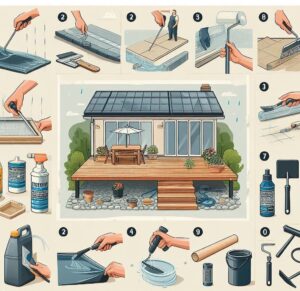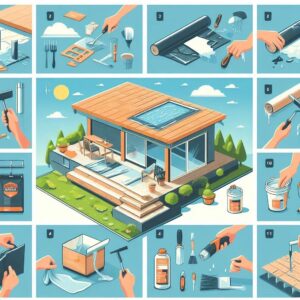Waterproofing is a crucial aspect of home maintenance that helps protect homes from water damage, mold, and structural issues. With the current rise of the DIY trend, several homeowners are tempted to handle home improvement tasks on their own, including waterproofing. While DIY can be beneficial for minor tasks, waterproofing is a complex process that leaves significant room for error, often leading to complications that are both hazardous and expensive to address.
Why DIY Waterproofing?
It’s not difficult to understand the reasons why a homeowner might be inclined to DIY waterproofing. Some common motivators include cost-saving, a desire for hands-on engagement, and the misconception that waterproofing is a simple task. These points appear advantageous on the surface—saving the cost of professional services, the feeling of accomplishment, and a perceived ease of job execution.
Common Mistakes in DIY Waterproofing

Waterproofing is an intricate and highly technical task that, unfortunately, often triggers a series of mistakes when performed by inexperienced DIY enthusiasts. Amateurs typically make a glut of avoidable errors, which can adversely impact the effectiveness of the waterproofing and may lead to severe, costly issues in the future.
Incomplete diagnosis of the problem: to properly waterproof your home, you must first correctly identify the source and extent of your water issues. This process involves meticulous scrutiny and understanding of your home’s structure and potential weak points. Unfortunately, DIY enthusiasts often possess only a superficial understanding, causing them to misdiagnose or underestimate the actual problems. Consequently, their remedial actions are frequently ineffective, allowing the root issues to continue unabated and potentially worsen over time.
Incorrect or insufficient waterproofing materials: different types of water damage require different waterproofing approaches and materials. Using incorrect or inadequate supplies is a typical mistake among DIY homeowners, leading to ineffective waterproofing. For instance, silicone-based sealants may work for minor leaks, but for more serious water intrusion issues, more robust solutions like elastomeric or polyurethane coatings might be necessary. Misjudging the severity of the problem can result in the use of inappropriate materials, leading to inefficient waterproofing and possible exacerbation of the water damage.
Ignoring local building codes and regulations: each area has specific building codes and ordinance regulations concerning waterproofing practices, ensuring the safety and longevity of structures. When homeowners attempt DIY waterproofing, they often overlook these regulations due to ignorance or the false belief that these steps are unnecessary. However, failing to adhere could lead to legal repercussions or hefty fines. Moreover, it could jeopardize the structural integrity of the home, causing more long-term damage.
Inadequate preparation before starting the task: another common mistake is improper surface preparation ahead of the waterproofing procedure. This preparation includes cleaning the surface carefully, removing any old paint or coatings, and fixing any visible cracks or gaps. A properly prepared surface ensures the waterproofing material adheres correctly and functions effectively. However, failing to thorough clean and prepare the surface often results in weak waterproofing and a shorter lifespan for the solution.
Neglecting proper safety measures: waterproofing often involves handling potentially harmful chemicals. Neglecting to use personal protective equipment such as gloves, safety goggles, and respirator masks can lead to injuries. Furthermore, working in poorly ventilated spaces could result in toxic fume inhalation. Safety mishaps like these are too common in DIY waterproofing endeavours, leading to unnecessary health risks.
In light of these potential pitfalls, DIY waterproofing can often create more profound problems than it resolves. Rather than taking a chance on these common mistakes, homeowners may be better off seeking professional services to ensure a proper, safe, and lasting waterproofing job.
The Impact and Consequences of DIY Mistakes

When DIY waterproofing goes awry, the fallout can be severe and enduring. Critically, these errors can catalyze lasting structural damage, which may compromise the safety and livability of your home. Water that continues to seep into the foundations or walls can erode the structure over time, undermining the material integrity of the building. This can lead to potentially life-threatening situations, particularly in areas prone to natural disasters, due to a weakened structural fortitude which can no longer resist adverse natural forces efficiently.
Water-damaged homes generally experience a tangible decrease in their property value. This depreciation is primarily because buyers are often aware of the considerable cost of repairing water damage and the potential health risks associated with mold and mildew. These health risks are another significant consequence of flawed waterproofing. Persistent moisture provides the ideal breeding ground for mold and mildew, which can cause a slew of health problems ranging from allergies and irritations to respiratory conditions, particularly in individuals with weak or compromised immune systems.
One of the most frustrating outcomes of these mistakes is the subsequent need for professional intervention. You might think you’re saving money by doing the waterproofing yourself, but incorrectly doing so can lead to more significant issues that require an expert’s input to rectify. Engaging professionals from the outset can preempt the issues that tend to arise from shoddy DIY waterproofing, leading to a more efficient use of time and resources.
While DIY waterproofing might seem like a cost-effective solution in the short-term, the long-term implications can be devastating both financially and in terms of health and safety. Therefore, it’s essential to approach waterproofing tasks with a keen understanding of the potential risks and requisite competence, or better yet, leave it to the professionals.
When to Consult a Professional
Recognizing when waterproofing tasks are too complex for a DIY approach is crucial. Certain issues, such as fixing foundational damage or installing complex drain systems, are best left to professionals. Hiring an expert ensures accurate problem diagnosis, proper use of quality materials, and adherence to local building codes—elements all critical to an effective, lasting waterproofing job. Ensure to consult reviews, ratings, and recommendations when choosing a professional.